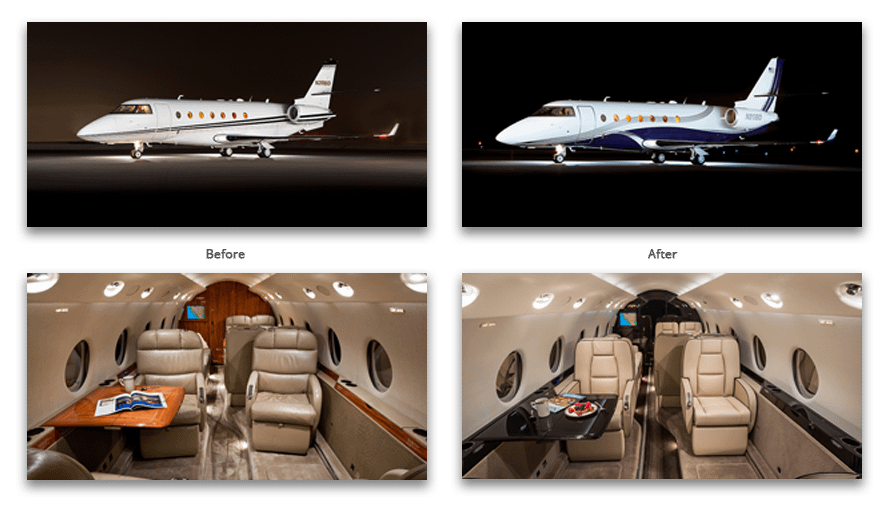Refurbishment Can Enhance Your Jet Experience
Pinnacle Aviation is a full service aircraft sales, acquisition, charter and management company based at Scottsdale Airport. For nearly 30 years, Pinnacle Aviation has assisted many buyers and sellers to maximize the value of their aircraft experience. After purchasing an aircraft, it is not unusual for a client to request a refurbishment of the interior and/or the exterior to fit their preferences and personality. Similar to a home remodel, the process of refurbishing the interior of a personal aircraft can become quite complex.
Refurbishment upgrades fall into three basic categories: 1) exterior, 2) interior, and 3) avionics. The costs associated with refurbishment can vary substantially depending on the scope of the work, the materials chosen, and the extent of any repairs needed. A full refurbishment greatly enhances the resale value of the aircraft, however a 100% return on investment will likely not occur. The industry generally assumes a 50% return on refurbishment costs depending on when the refurbishment was completed, however the salability will greatly improve. The motivation to refurbish an aircraft, is usually for the owner’s personal pride and enjoyment of their aircraft.
Pinnacle Aviation recently assisted a client with interviewing and vetting aircraft refurbishment facilities – ultimately selecting the highly-acclaimed West Star Aviation (www.weststaraviation.com) based in East Alton, Illinois. West Star Aviation specializes in major modifications and interior refurbishment; as well as, repair and maintenance of airframes, engines, avionics installations and repair, accessory services, and exterior paint.
Because every owner is unique, every design and refurbishment project is different. A typical refurbishment project takes four to eight weeks to complete, depending on the scope of work.
Once the design team is chosen, they begin working with the owner to select the paint scheme and make an initial wish list; to include things such as: high-speed internet connectivity; entertainment systems; moving map systems; size and number of video monitors; and type and style of seating. And then, all of the galley amenities – types of ovens and warmers, coffee and cappuccino makers; lighting fixtures throughout the cabin; lavatory amenities and preferences – and finally, selecting the carpet, fabrics, leathers, and metal plating for latches and buckles.
Everything that will be upgraded and installed is listed, prioritized, and scheduled in the right sequence. For instance, the wiring for all of the electronics must be completed before the interior components can be installed; the new carpeting is one of the last things to be done. An error in the project sequence can create unnecessary expenses in wasted time and materials.
Debi Cunningham, Vice President Marketing & Interior Design, with West Star Aviation explains, “once the contract is signed for the work, our design team moves forward with designs until approved by the customer, once approved everything is ordered…we like to have everything approved, ordered and in-house (if possible) by the time the aircraft arrives for the work…that way we have no hold ups due to delayed delivery of materials”. Ms. Cunningham continues, “once in-house, we work continually on the interior items (including wood) while the aircraft is going through stripping, exterior painting, and any maintenance work, so when done, the interior/wood can start going back into the aircraft, along with the headliner/valance panels, usually the carpet is the last to go in, once all the seats, wood cabinetry, bulkheads, galley/lavatory is back in, the carpet is fit, taken back out and serged, then refit and fully installed.”
During the planning and design phase, the interior of the aircraft is often completely stripped out, exposing the airframe and all of the wiring.
Pinnacle Aviation’s recent client designed a new paint scheme for their jet to convey personality and enhance ramp presence. While the interior materials were being gathered, the exterior painting project began. Painting an aircraft involves much more than just shooting a glossy coat of paint. As with most aspects of the refurbishment, the value is in the details. The exterior paint project took about 4 weeks to complete and the interior work began on schedule.
Ms. Cunningham adds, “After the job is complete, we normally do a test flight, when the test flight comes back and all checks out, the customer is good go”.
Pinnacle Aviation has worked with West Star Aviation on many refurbishment projects over the past two decades. Our clients continue to challenge the status quo and persistently push the design teams to add new amenities and innovative technologies. It is always inspiring to see their creativity manifest with each new project.



